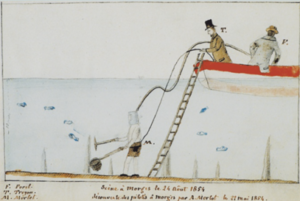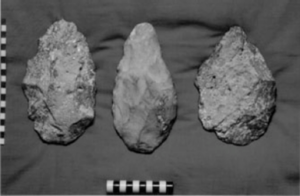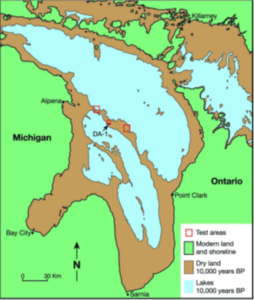By Ann S. Eberwein
“Beneath the surface of our oceans, lakes, rivers, and wetlands lies a physical record of humankind preserved in prehistoric and historic shorelines, shipwrecks, inundated cities, harbors, and other traces of our past.”
– Advisory Council on Underwater Archaeology
The first underwater archaeological expedition took place over 150 years ago. The dive was conducted on Lake Geneva in Switzerland on May 22, 1854, by Alphonse Morlot, a Bernese geologist. Morlot wore an unsophisticated diving bell, the design of which prohibited him from bending down to pick up artifacts. Instead, he used a net and rake to scoop rocks from the lake floor but was unable to retrieve prehistoric artifacts left by the inhabitants of the ancient lake dweller village that had once stood.

Rendering of Alphonse Morlot’s dive in Lake Geneva accompanied by Frédéric Troyon and François-Alphonse Forel (Image credit: Musee Cantonal Geologie https://hist-geol-unil.ch/en/personnes/morlot-charles-adolphe/).
Since Morlot’s first dive, diving equipment and underwater archaeology have significantly advanced. Nowadays, incredible discoveries are made underwater with exceptional regularity. These discoveries contribute a great deal to the field of archaeology because water levels all over the world were much lower in prehistory. At the end of the most recent ice age, global sea levels increased by around four hundred feet submerging not just coasts, but low-lying regions such as Patagonia, which was reduced to half of its previous size. Evidence of human and Neanderthal activity has been discovered in a submerged region called Doggerland, located in the North Sea, which used to connect the British Isles and mainland Europe. This region remained above water until approximately 6500 BC.
Archaeological sites, especially prehistoric sites, are commonly found on shorelines because these environments often provide an abundance of food and other resources. This means that, without searching beneath the depths of the ocean, our collective understanding of prehistory is limited. Some examples of finds from submerged ancient coastlines include three Acheulean handaxes found in Table Bay, South Africa, and a Homo erectus mandible found off the coast of Taiwan.

Three Acheulean handaxes recovered from Table Bay, South Africa in 1995 and 1996 during the excavation of a Dutch East India Company vessel called Waddinxveen, which ran aground in 1697 (photo credit: Werz and Flemming 2001).
The peopling of the Americas has been the subject of intense debate for decades, and underwater excavations provide important evidence of coastal travel and human occupation. For example, the Page-Ladson site on the Aucilla River in Florida has yielded evidence of mastodon butchery dating 14,500 years in addition to 7,000 years of preserved stratigraphy. Another example comes from Mexico, where in the Hoyo Negro cenote in the state of Quintana Roo, the complete skeleton of a young woman was discovered. DNA from the woman’s remains was preserved by the underwater environment and her genome analysis supports the hypothesis that the earliest Americans were descended from a single group that migrated to the Americas from Asia. Current long-term projects in the Haida Gwaii archipelago off the coast of British Columbia, in southern California, and on the Atlantic continental shelf are aimed at uncovering additional information about the peopling of the Americas.
In addition to changes in coastlines, the melting of glaciers since the end of the last glacial maximum has had a significant impact on inland bodies of water such as rivers and lakes, sometimes causing long-term water level fluctuations in the case of the latter. For example, due to glacial melting and isostatic rebound, the North American Great Lake water levels have been dynamic over the last 18,000 years. Between 10,000 and 8,000 years ago, low water levels on Lake Huron exposed the Alpeny-Amberley Ridge which once linked Michigan and Ontario.

Modern and prehistoric Lake Huron with the Alpena-Amberley Ridge bisecting it. DA-1 indicates the location where stone artifacts made of obsidian from Oregon were found (image credit: O’Shea et al. 2021)
Beginning in 2008 a combination of acoustic survey, videos taken using a remotely operated vehicle, and mapping and sampling by scuba-trained archaeologists have revealed several archaeological sites on this ridge. The identification of these sites is made possible because the ridge cuts across the center of the lake where very little sediment has accumulated, meaning that structures, artifacts, pollen, wood, charcoal, and other sources of archaeological data remain on the surface of the lake floor. Some of the finds from the ridge include a drive line and V-shaped hunting blinds that were used to hunt caribou and two flakes made of obsidian from a source on Wagontire Mountain in Central Oregon. The evidence of caribou hunting is significant because drive lines and hunting blinds dating back thousands of years are rarely preserved. In addition, finding obsidian so far from its source has implications for our understanding of mobility and social contacts in the early Holocene.
Returning to the 1854 dive attempt described earlier, underwater archaeology at lake dwellings in the circum-Alpine region of Europe has been conducted with increasing regularity by archaeologists since the 1970s. Initially, many new methods were developed such as water-jet pipes to improve visibility and the use of dry diving suits which are necessary since underwater excavations in this region have to be carried out in winter. Once these and other methods were incorporated into practice, the scale of underwater excavations of lake dwellings increased. For example, from 1981 to 1984, a team led by Béat Arnold excavated an entire village of over 7,000 square meters at the Cortaillod-Est, Late Bronze Age site on Lake Neuchâtel in Switzerland. In another example, a rescue excavation on Lake Biel, Switzerland that began in 1988 documented 25,000 square meters of the lake floor. This excavation of the Sutz-Lattrigen settlement revealed 20 Neolithic villages built in the same location between 3840 and 2688 BC and was able to trace changes in house orientation, size, and building techniques, and differences in village layouts.
The examples of finds and excavations discussed thus far come from our prehistory, but when most people think of underwater archaeology, they think of maritime archaeology, which often focuses on historical and classical shipwrecks. However, maritime archaeology extends into prehistory as well. For example, early human migrations to Australia 40,000 years ago and to Japan 38,000 years ago could not have happened without the use of rafts or boats. Further evidence of early seafaring in Japan comes from obsidian found on the mainland that was sourced from Kozushima Island. Since this island was thirty kilometers off the coast of Japan during the last glacial maximum, obtaining obsidian from there would have required the use of watercraft. A final example of early seafaring comes from the Mediterranean Sea, where Middle Paleolithic and Mousterian tools have been found on Crete and the Ionian Islands. This suggests that Homo sapiens may not have been the first seafarers since Mousterian tools are distinctive and associated specifically with Neanderthals.
Clearly there is much to be discovered in lakes and rivers, an ancient seafaring revolution to explore, and a whole dimension of our prehistory to investigate beneath submerged coastlines around the world. This fall, underwater archaeologist Ashley Lemke joins the UWM Department of Anthropology faculty. Dr. Lemke has made numerous contributions to the field of underwater archaeology including her work in Lake Huron on the Alpeny-Amberley Ridge described above. UWM undergraduate (students with junior standing) and graduate students can learn more about underwater archaeology from Dr. Lemke in a new seminar offered this fall!
See below for details and course description:

Course: ANTHRO 641.002 U/G Underwater Archaeology
Instructor: Professor Ashely Lemke
Meeting: Fall 2023, W 12:30 pm – 3:10 pm
Course Description: Archaeologists learn about past societies by examining the material they leave behind. These materials can include anything affected by human behavior — from small disturbances in the soil to architectural remains, from sacred objects to the mundane refuse of daily life. In some cases this material adds to what we know from historical accounts, but most often, archaeology gives us a picture of the past that we would never otherwise see. Sometimes, archaeological sites are found underwater, such as the remains of a shipwreck or a landscape that was once dry land. Underwater sites offer some of the best preserved but most challenging archaeological contexts to research. This course will introduce students to archaeology underwater, including methods, research questions, great discoveries, and the history of investigation. It will cover vast stretches of time and space, from historic shipwrecks in the Mediterranean to >10,000 year old prehistoric sites in North and South America. Underwater archaeology is an emerging field in anthropology more generally – and this course will explore its important role in the future of archaeology.
Sources:
Advisory Council on Underwater Archaeology. Retrieved July 24, 2023, from https://acuaonline.org/
Hafner, A. (2004). Underwater Archaeology, Lake-Dwellings below the water surface. In Living on the lake in prehistoric Europe: 150 years of lake-dwelling research, edited by F. Menotti, p.178-193.
Lemke, A. (2020): Submerged prehistory and anthropological archaeology: Do underwater studies contribute to theory?, The Journal of Island and Coastal Archaeology, DOI:10.1080/15564894.2020.1782540
O’Shea, J. M., Lemke, A. K., Nash, B. S., Sonnenburg, E. P., Ferguson, J. R., Nyers, A. J., & Riebe, D. J. (2021). Central Oregon obsidian from a submerged early Holocene archaeological site beneath Lake Huron. Plos one, 16(5), e0250840.
O’Shea, J. M., Lemke, A. K., Sonnenburg, E. P., Reynolds, R. G., & Abbott, B. D. (2014). A 9,000-year-old caribou hunting structure beneath Lake Huron. Proceedings of the National Academy of Sciences, 111(19), 6911-6915.